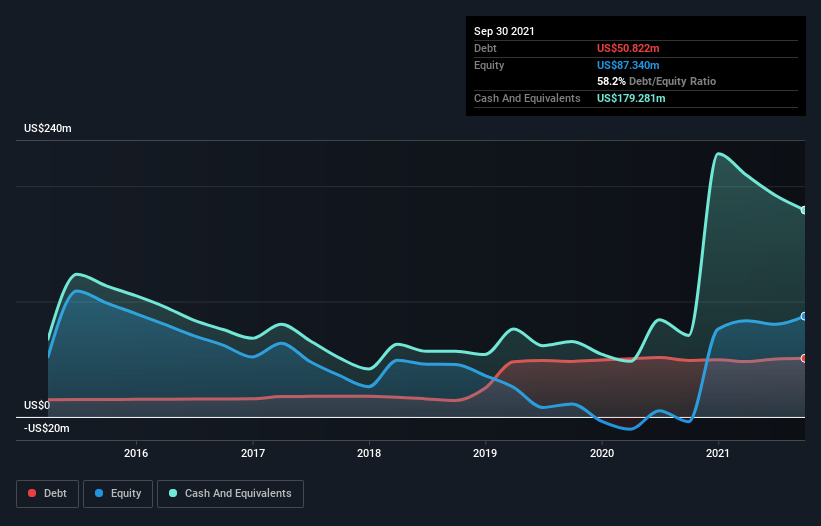Ocular Therapeutix (NASDAQ:OCUL) May Not Be Profitable But It Seems To Be Managing Its Debt Just Fine, Anyway
David Iben put it well when he said, 'Volatility is not a risk we care about. What we care about is avoiding the permanent loss of capital.' It's only natural to consider a company's balance sheet when you examine how risky it is, since debt is often involved when a business collapses. We note that Ocular Therapeutix, Inc. (NASDAQ:OCUL) does have debt on its balance sheet. But the more important question is: how much risk is that debt creating?
When Is Debt A Problem?
Generally speaking, debt only becomes a real problem when a company can't easily pay it off, either by raising capital or with its own cash flow. Part and parcel of capitalism is the process of 'creative destruction' where failed businesses are mercilessly liquidated by their bankers. While that is not too common, we often do see indebted companies permanently diluting shareholders because lenders force them to raise capital at a distressed price. By replacing dilution, though, debt can be an extremely good tool for businesses that need capital to invest in growth at high rates of return. The first step when considering a company's debt levels is to consider its cash and debt together.
View our latest analysis for Ocular Therapeutix
What Is Ocular Therapeutix's Net Debt?
As you can see below, Ocular Therapeutix had US$50.8m of debt, at September 2021, which is about the same as the year before. You can click the chart for greater detail. However, its balance sheet shows it holds US$179.3m in cash, so it actually has US$128.5m net cash.
A Look At Ocular Therapeutix's Liabilities
We can see from the most recent balance sheet that Ocular Therapeutix had liabilities of US$25.2m falling due within a year, and liabilities of US$105.2m due beyond that. Offsetting these obligations, it had cash of US$179.3m as well as receivables valued at US$19.6m due within 12 months. So it actually has US$68.4m more liquid assets than total liabilities.
This short term liquidity is a sign that Ocular Therapeutix could probably pay off its debt with ease, as its balance sheet is far from stretched. Simply put, the fact that Ocular Therapeutix has more cash than debt is arguably a good indication that it can manage its debt safely. When analysing debt levels, the balance sheet is the obvious place to start. But it is future earnings, more than anything, that will determine Ocular Therapeutix's ability to maintain a healthy balance sheet going forward. So if you want to see what the professionals think, you might find this free report on analyst profit forecasts to be interesting.
In the last year Ocular Therapeutix wasn't profitable at an EBIT level, but managed to grow its revenue by 213%, to US$39m. That's virtually the hole-in-one of revenue growth!
So How Risky Is Ocular Therapeutix?
By their very nature companies that are losing money are more risky than those with a long history of profitability. And the fact is that over the last twelve months Ocular Therapeutix lost money at the earnings before interest and tax (EBIT) line. And over the same period it saw negative free cash outflow of US$57m and booked a US$88m accounting loss. With only US$128.5m on the balance sheet, it would appear that its going to need to raise capital again soon. Importantly, Ocular Therapeutix's revenue growth is hot to trot. High growth pre-profit companies may well be risky, but they can also offer great rewards. When analysing debt levels, the balance sheet is the obvious place to start. However, not all investment risk resides within the balance sheet - far from it. Be aware that Ocular Therapeutix is showing 2 warning signs in our investment analysis , you should know about...
If, after all that, you're more interested in a fast growing company with a rock-solid balance sheet, then check out our list of net cash growth stocks without delay.
Have feedback on this article? Concerned about the content? Get in touch with us directly. Alternatively, email editorial-team (at) simplywallst.com.
This article by Simply Wall St is general in nature. We provide commentary based on historical data and analyst forecasts only using an unbiased methodology and our articles are not intended to be financial advice. It does not constitute a recommendation to buy or sell any stock, and does not take account of your objectives, or your financial situation. We aim to bring you long-term focused analysis driven by fundamental data. Note that our analysis may not factor in the latest price-sensitive company announcements or qualitative material. Simply Wall St has no position in any stocks mentioned.

 Yahoo Finance
Yahoo Finance 
